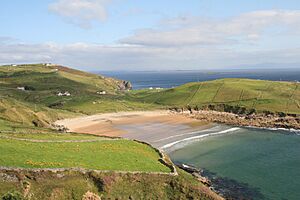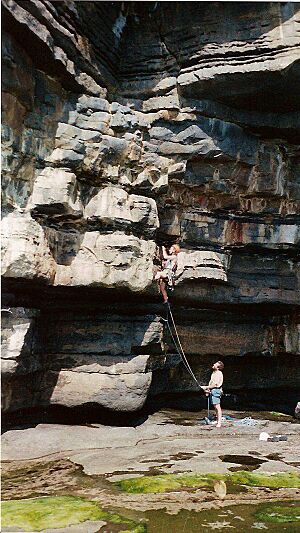Muckross Head facts for kids
Muckross Head is a cool piece of land that sticks out into the sea. It's found in County Donegal, in the northwest of Ireland. This spot is famous for its amazing rock climbing area. It has a very special rock structure that makes climbing here unique.
Contents
Exploring Muckross Head
Muckross Head has two beaches, each with its own special features.
Beaches for Fun
One beach is called Trá na nGlór, which means "beach of the noise" in Irish. This beach is popular with surfers. It has a strong current called a rip tide, but it's usually safe if you know about it.
The other beach is called Trá Bán, meaning "white beach". This is a great family beach and is safe for swimming. Just be careful of small rocks that might fall from the cliffs. This beach also has a public car park and toilets during the summer months.
A Look at History
There's a public monument at the very tip of Muckross Head. It's known locally as "The Market House". Long ago, this spot was likely used for selling farm goods and animals like sheep and pigs.
There used to be an old wall across the headland. It might have been built for defense a very long time ago. Most of its stones were used by local farmers to build their houses and sheds.
Nature and Fossils
Muckross Head is home to many different animals and plants. It also has a small area of limestone rock that you can see. In some places, you can even find fossils! These are mostly ancient seaweeds and seashells.
Nearby Places
Muckross Head sits at the bottom of a hill about 250 meters tall, known as Muckross Hill. The closest village is Kilcar, which is about 3 kilometers to the west.
You can also see Inisduff island from the coast road. It's a small, uninhabited island about 5 kilometers southeast of Muckross Head.
Rock Climbing at Muckross Head
The climbing area at Muckross Head is a sea-cliff. It's not very big and is far from big cities, but climbers love it because of its unique challenges. It's easy to get to, even though it's above a rocky area that can be covered by the tide.
Unique Rock Formations
The rock here is made of Sandstone layers with thin layers of Mudstone in between. Over time, the mudstone has worn away, creating horizontal breaks and overhangs. This means many climbs involve going under or over parts of the rock!
Most climbs are "single-pitch," meaning you climb from 10 to 20 meters without stopping. Because of the overhangs, climbing here can be very tough and exciting.
Climbing Routes and Safety
The latest climbing guide, published in 2015, lists over 60 different climbs at Muckross. These climbs have different difficulty levels, or "grades." There are climbs for all skill levels, but many are for more experienced climbers.
Climbers here use "traditional protection." This means they place their own safety gear into cracks in the rock as they climb. They then remove it when they are done. This method is also called "clean climbing" because it leaves no permanent marks on the rock. Medium to large cams are very useful for this type of climbing.



